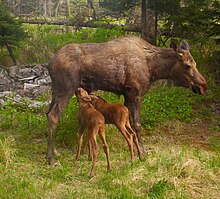Milk immunity is the protection provided to immune system of an infant via the biologically active components in milk, typically provided by the infant's mother.
Mammalian milk

All mammalian milk contains water, sugar, fat, vitamins, and protein with the variation within and between species and individuals differing mainly in the amount of these components. Other than the variation in quantity of these components, not a lot is known about bio-active or immune-modulating factors in many mammalian species. However, in comparison to other mammalian milk, human milk has the most oligosaccharide diversity.
Bovine milk
Ruminant mothers do not transfer immunity to their infants during pregnancy, which makes milk the first introduction to maternal immunity calves receive. Bovine milk contains both immunoglobulins A and G, but in contrast to human milk where IgA is the most abundant, IgG is more abundant. Secretory Component, IgM, both anti-inflammatory and inflammatory cytokines, and other proteins with antimicrobial functions are also present in bovine milk.
Human milk
This section is an excerpt from Human milk immunity.
Human milk immunity is the protection provided to the immune system of an infant via the biologically active components in human milk. Human milk was previously thought to only provide passive immunity primarily through Secretory IgA, but advances in technology have led to the identification of various immune-modulating components. Human milk constituents provide nutrition and protect the immunologically naive infant as well as regulate the infant's own immune development and growth.
Immune factors and immune-modulating components in human milk include cytokines, growth factors, proteins, microbes, and human milk oligosaccharides. Immune factors in human milk are categorized mainly as anti-inflammatory primarily working without inducing inflammation or activating the complement system.Avian crop milk
Crop milk is a secretion from the crop of a bird that is regurgitated to feed their offspring. Birds that produce this secretion include pigeons, flamingos, emperor penguins, and doves. Pigeon milk contains some immune-modulating factors such as microbes and IgA, as well as other components with similar biological activities to mammalian milk including pigeon growth factor, and transferrin.
References
- Power, Michael L.; Schulkin, Jay (2016). The Biology of Lactation Milk. Baltimore, Maryland: Johns Hopkins University Press. p. 4. ISBN 978-1-4214-2043-1.
- Martin, M.A.; Sela, D.A. (2013). "Infant Gut Microbiota: Developmental Influences and Health Outcomes". In Clancy, KB; Hinde, K; Rutherford, JN (eds.). Building Babies. New York: Springer. pp. 233–256. doi:10.1007/978-1-4614-4060-4_11. ISBN 9781461440598.
- ^ Stelwagen K, Carpenter E, Haigh B, Hodgkinson A, Wheeler TT (April 2009). "Immune components of bovine colostrum and milk". Journal of Animal Science. 87 (13 Suppl): 3–9. doi:10.2527/jas.2008-1377. PMID 18952725. S2CID 43829526.
- Cakebread JA, Humphrey R, Hodgkinson AJ (August 2015). "Immunoglobulin A in Bovine Milk: A Potential Functional Food?". Journal of Agricultural and Food Chemistry. 63 (33): 7311–6. doi:10.1021/acs.jafc.5b01836. PMID 26165692.
- Petherick A (December 2010). "Development: Mother's milk: A rich opportunity". Nature. 468 (7327): S5-7. Bibcode:2010Natur.468S...5P. doi:10.1038/468S5a. PMID 21179083.
- ^ Miller E (2018). "Beyond Passive Immunity Breastfeeding, milk and collaborative mother-infant immune systems". In Tomori C, Palmquist AE, Quinn EA (eds.). Breastfeeding New Anthropological Approaches. New York: Routledge. pp. 26–36. ISBN 978-1-138-50287-1.
- Garofalo R (February 2010). "Cytokines in human milk". The Journal of Pediatrics. 156 (2 Suppl): S36-40. doi:10.1016/j.jpeds.2009.11.019. PMID 20105664.
- Martin MA, Sela DA (2013). "Infant Gut Microbiota: Developmental Influences and Health Outcomes". In Clancy KB, Hinde K, Rutherford JN (eds.). Building Babies. New York: Springer. pp. 233–256. doi:10.1007/978-1-4614-4060-4_11. ISBN 9781461440598.
- Collado MC, Cernada M, Baüerl C, Vento M, Pérez-Martínez G (2012-07-14). "Microbial ecology and host-microbiota interactions during early life stages". Gut Microbes. 3 (4): 352–65. doi:10.4161/gmic.21215. PMC 3463493. PMID 22743759.
- Cabrera-Rubio R, Collado MC, Laitinen K, Salminen S, Isolauri E, Mira A (September 2012). "The human milk microbiome changes over lactation and is shaped by maternal weight and mode of delivery". The American Journal of Clinical Nutrition. 96 (3): 544–51. doi:10.3945/ajcn.112.037382. PMID 22836031.
- Palmeira P, Carneiro-Sampaio M (September 2016). "Immunology of breast milk". Revista da Associação Médica Brasileira. 62 (6): 584–593. doi:10.1590/1806-9282.62.06.584. PMID 27849237.
- Eraud C, Dorie A, Jacquet A, Faivre B (2008). "The crop milk: a potential new route for carotenoid-mediated parental effects" (PDF). Journal of Avian Biology. 39 (2): 247–251. doi:10.1111/j.0908-8857.2008.04053.x. ISSN 1600-048X. Archived (PDF) from the original on 2022-05-16. Retrieved 2022-06-14.
- Power, Michael L.; Schulkin, Jay (2016). "Feeding Offspring". The Biology of Lactation Milk. Baltimore, Maryland: Johns Hopkins University Press. pp. 26–27. ISBN 978-1-4214-2042-4.
- Gillespie MJ, Stanley D, Chen H, Donald JA, Nicholas KR, Moore RJ, Crowley TM (2012-10-26). "Functional similarities between pigeon 'milk' and mammalian milk: induction of immune gene expression and modification of the microbiota". PLOS ONE. 7 (10): e48363. Bibcode:2012PLoSO...748363G. doi:10.1371/journal.pone.0048363. PMC 3482181. PMID 23110233.